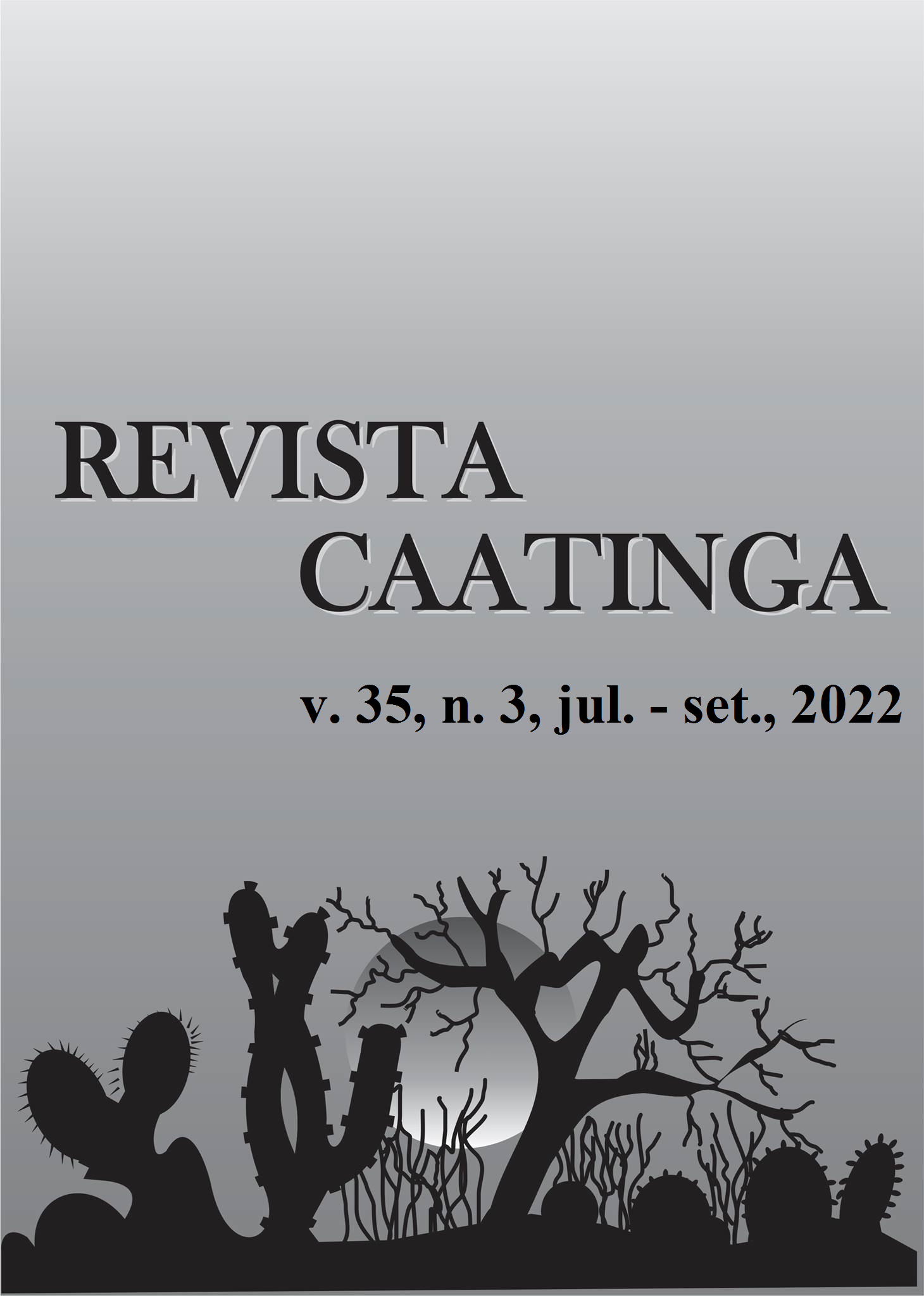INDUCTION OF POLYPLOIDY IN WATERMELON GENOTYPE WITH POWDERY MILDEW RESISTANCE (Podosphaera xanthii)
DOI:
https://doi.org/10.1590/1983-21252022v35n301rcKeywords:
Chromosomal duplication. Tetraploidy. Cytogenetics. Citrullus lanatus.Abstract
Triploid watermelon is highly appreciated by the most demanding markets, and due to its small size, it is ideal for consumption by small families. With the growth in areas cultivated with seedless watermelon worldwide, there is a demand for the development of tetraploid germplasm to obtain triploid hybrids with better agronomic performance. This study performed two tests to induce polyploidy in the powdery mildew–resistant line developed by Embrapa Semi-Arid, LDRO, under different colchicine concentrations and application methods. In Experiment 1, the seeds were treated with colchicine (0.0%, 0.1%, and 0.2%) for 24 h and 48 h. In Experiment 2, 0.2% colchicine was applied by different methods: (a) directly on the seed (MDS) with and without scarification, (b) on seeds with radicle emission (MER), (c) at the insertion point between the hypocotyl and the root (MIHR), (d) at the seedling apex (MAP), and (e) in the inverted hypocotyl (MHI). Chromosome count (cytogenetic analysis), number of chloroplasts per pair of guard cells, number of stomata, seedling height, and hypocotyl diameter were measured. In the LDRO line, chromosomal duplication occurred in some plant cells, but it was not possible to obtain 100% tetraploid plants. Colchicine (0.2%) for 48 h without mechanical scarification induced chromosomal duplication in watermelon. The analysis of the number of chloroplasts identified the level of ploidy early, reducing the number of plants needed to be evaluated by cytogenetics, which allowed us to more accurately identify the different levels of ploidy of the plant.
Downloads
References
CARVALHO, R. N. Cultivo de melancia para a agricultura familiar. 2.ed. rev., ampl. Brasília, DF: Embrapa Informação Tecnológica, 2005.
CHEN, J-T.; COATE, J. E.; MERU, G. Editorial: Artificial Polyploidy in Plants. Frontiers in Plant Science, 11: 1-3, 2020.
COMPTON, M. E. et al. Identification of tetraploid regenerants from cotyledons of diploid watermelon cultured in vitro. Euphytica, 87: 165-172, 1996.
DAUGHTREY, M. L. et al. The powdery mildews. In: OWNLEY, B. H.; TRIGIANO, R. N. Plant Pathology: Concepts and laboratory exercises. Boca Raton: CRC Press, 2017. cap. 12, p. 191-204.
DERMEN, H. Colchicine polyploidy and technique. Botanical Review, 6: 11, 599-635, 1940.
DIAS, R. C. S.; SANTOS, J. S. Panorama nacional da produção de melancia. 2019. Disponível em: https://revistacampoenegocios.com.br/panorama-nacional-da-producao-de-melancia/. Acesso em: 26 ago. 2021.
DINNO, A. Dunn.test: Dunn's Test of Multiple Comparisons Using Rank Sums. R package version 1.3.4. https://CRAN.R-project.org/package=dunn.test, 2017.
GUERRA, M.; SOUZA, M. J. Como observar cromossomos: um guia de técnicas em citogenética vegetal, animal e humana. Ribeirão Preto: Fundação de Pesquisas Científicas de Ribeirão Preto, 2002. 132 p.
HANDAYANI, R. S.; YUSUF, M.; AKMAL, A. Potential changes in watermelon (Citrullus lannatus) ploidy treated by colchicine. Journal of Tropical Horticulture, 1: 10-14, 2018.
IBGE - Instituto Brasileiro de Geografia e Estatística. Produção Agrícola Municipal. 2019. Disponível em: <https://sidra.ibge.gov.br/tabela/1612>. Acesso em: 16 ago. 2021.
JASKANI, M. J. et al. Flow cytometry of DNA content of colchicine treated with watermelon as a ploidy screening method at M1 stage. Pakistan Journal of Botany, 37: 685-696, 2005.
KIHARA, H. Triploid watermelon. Proceedings of the American Society for Horticultural Science, 58: 217-230, 1951.
KOH, G. C. Tetraploid production of Moodeungsan watermelon. Jounal of the Korean Society for Horticultural Science, 43: 671-676, 2002.
LIMA T. N. et al. Caracterização agronômica e heterose em genótipos de melancia. Pesquisa Agropecuária Tropical, 48: 170–177, 2018.
MCCUISTION, F.; ELMSTROM, G. W. Identifying polyploids of various cucurbits by stomatal guard cell chloroplast number. Proceedings of Florida State Horticultural Society, 106: 155-157, 1993.
MEDINA, D. M. et al. A poliploidia artificial na obtenção de melancia sem semente. Bragantia, 17: 81-100, 1958.
MDIC/SECEX. Ministério do Desenvolvimento, Indústria e Comércio Exterior. Comex vis: principais produtos exportados. 2018. Disponível em: <http://www.mdic.gov.br/comercio exterior/estatisticas-de-comercio-exterior/comex-vis/frame-ppe?ppe=1235. Acesso em: 22 ago. 2018.
NOH, J. et al. Screening different methods of tetraploid induction in watermelon [Citrullus lanatus (thunb.) Manst. and Nakai]. Horticulture Environment Biotechnology, 53: 521-529, 2012.
RAVEN, P. H.; EVERT, R. F.; EICHHORN, S. E. Biologia vegetal. 5. ed. Rio de Janeiro, RJ: Guanabara Koogan, 1996. 172-226 p.
R CORE TEAM. R: A language and environment for statistical computing. R Foundation for Statistical Computing, Vienna, Austria. URL https://www.R-project.org/, 2016.
ROTH, P. S. Indução de poliploidia em clones de (Eucalyptus urophylla) S. T. Blake. 1984. 78 f. Dissertação (Mestrado em Engenharia Florestal). Escola Superior de Agronomia “Luiz de Queiroz”, Piracicaba, 1984.
SHEIKH, S. et al. Phenotypic markers for tetraploid watermelon [Citrullus lanatus (Thunb.) MATSUM. ET NAKAI following parental exposure to colchicine in T0 generation. Horticulture Environment Biotechnology, 54: 524-530, 2013.
SOUZA, F. F. et al. Desenvolvimento de híbridos triploides experimentais de melancia. Sitientibus, 1: 154-160, 2001.
SOUZA, F. F., QUEIRÓZ, M. A. Avaliação de caracteres morfológicos úteis na identificação de plantas poliploides de melancia. Horticultura Brasileira, 22: 516-520, 2004.
STADNIK, M. J.; RIVERA, M. C. Oídios. Jaguariúna, SP: Embrapa Meio Ambiente, 2001. 484 p.
Downloads
Published
Issue
Section
License
Os Autores que publicam na Revista Caatinga concordam com os seguintes termos:
a) Os Autores mantêm os direitos autorais e concedem à revista o direito de primeira publicação, com o trabalho simultaneamente licenciado sob a Licença Creative Commons do tipo atribuição CC-BY, para todo o conteúdo do periódico, exceto onde estiver identificado, que permite o compartilhamento do trabalho com reconhecimento da autoria e publicação inicial nesta revista, sem fins comerciais.
b) Os Autores têm autorização para distribuição não-exclusiva da versão do trabalho publicada nesta revista (ex.: publicar em repositório institucional ou como capítulo de livro), com reconhecimento de autoria e publicação inicial nesta revista.
c) Os Autores têm permissão e são estimulados a publicar e distribuir seu trabalho online (ex.: em repositórios institucionais ou na sua página pessoal) a qualquer ponto antes ou durante o processo editorial, já que isso pode gerar alterações produtivas, bem como aumentar o impacto e a citação do trabalho publicado (Veja O Efeito do Acesso Livre).







